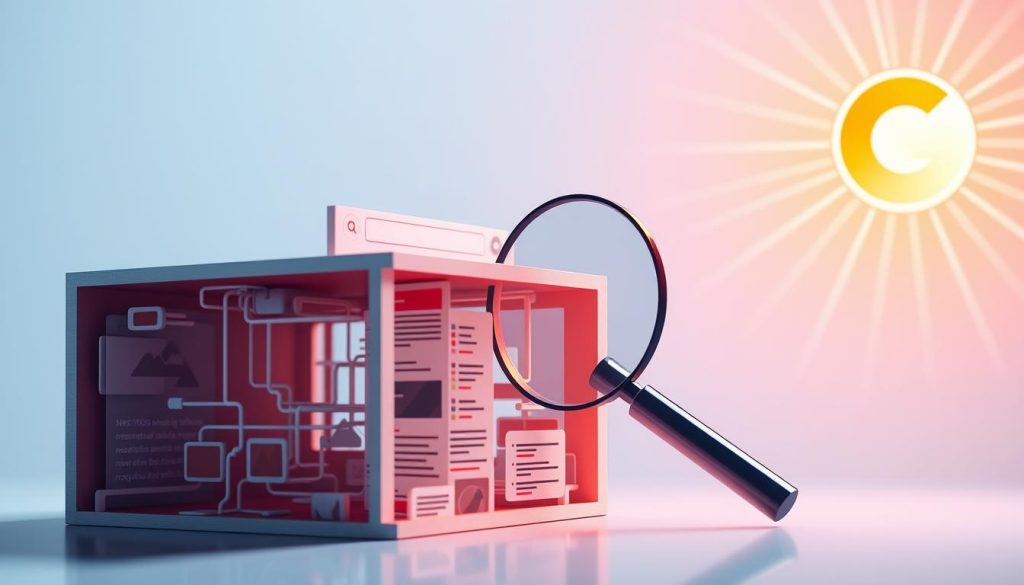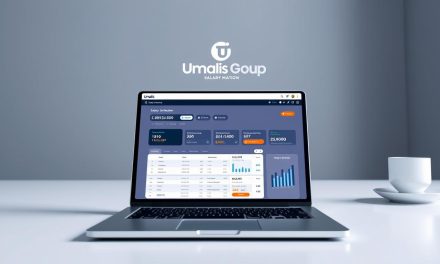Imagine your website as a city. Without clear roads, visitors get lost and search engines struggle to map the terrain. This is where internal linking becomes your most powerful tool. These hyperlinks connect different pages on your site, creating a clear path for everyone.
Every link you place acts as a guide. It helps search engines like Google discover and understand all your valuable content. For users, it’s a seamless way to find more relevant information without leaving your website. This dual function makes it a cornerstone of modern SEO.
A well-planned network of internal links does more than just aid navigation. It builds topical authority, telling search engines your site is a deep resource on a subject. It can also keep visitors engaged longer, reducing bounce rates. Mastering this strategy is key to unlocking your website’s full potential in search results. For a deeper dive, explore these advanced strategies de linking interne.
Table of Contents
Key Takeaways
- Internal linking acts as a roadmap for both search engines and users navigating your website.
- It helps search engines find, index, and understand the relationship between your pages.
- A strong internal linking structure improves your site’s topical authority and SEO performance.
- It enhances user experience by guiding visitors to relevant content, keeping them engaged.
- Strategic internal linking can lead to better search rankings and lower bounce rates.
Understanding Internal Linking: The SEO Foundation
At the core of every well-structured website lies a strategic system of connections between its various pages. These connections form the backbone that supports both user navigation and search engine understanding.
Internal links are hyperlinks that point from one page to another within the same domain. The basic HTML structure uses the anchor tag: <a href="https://yourdomain.com/page" title="Descriptive Text">Anchor Text</a>. This simple code creates pathways that browsers and search engines follow.
These connections serve three vital purposes. They enable smooth user navigation through your site. They establish a clear information hierarchy across your pages. Most importantly, they distribute ranking power throughout your website.
Unlike external links that send visitors to other domains, internal connections keep users within your website. This distinction is crucial for maintaining engagement and controlling the user journey.
For SEO, proper internal linking is fundamental. Search engines rely on these pathways to discover and index content. Pages without incoming links may remain invisible to crawlers, missing valuable ranking opportunities.
How Internal Linking Enhances Site Crawlability and User Experience
The true power of website connectivity emerges when links serve dual purposes for technology and people alike. A strategic approach to internal linking simultaneously improves how search engines understand your site and how visitors navigate your content.

Boosting Crawl Efficiency
Search engines rely on internal links to discover and index your pages. Google’s Search Advocate John Mueller emphasizes this importance:
« It’s one of the biggest things that you can do on a website to kind of guide Google and guide visitors to the pages that you think are important. »
These connections create a roadmap for crawlers. They help determine which content deserves priority indexing and establish your site’s hierarchy.
| Benefit Area | Search Engine Impact | User Impact |
|---|---|---|
| Discovery | Crawlers find new pages faster | Users discover relevant content |
| Priority | Important pages get indexed first | Key information becomes accessible |
| Understanding | Site structure becomes clear | Navigation feels intuitive |
Improving User Engagement
Strategic placement of links within your content keeps visitors exploring longer. This reduces bounce rates and increases the likelihood of conversions.
Contextual links guide users to related information seamlessly. They prevent visitors from feeling lost while encouraging deeper engagement with your website. For comprehensive guidance on implementing these strategies, explore our detailed internal linking techniques.
Increased time on site and higher page views send positive signals to search engines. This creates a virtuous cycle where better user experience leads to improved SEO performance.
Exploring the Types of Internal Links
Your website’s architecture uses different connection styles to guide visitors and search engines. Each type serves a unique purpose in the overall structure. Understanding these variations helps optimize both user experience and SEO performance.
Not all connections between pages serve the same function. Some provide primary navigation while others offer contextual guidance. This diversity creates a comprehensive browsing experience.
Navigational and Footer Links
Navigational links form the backbone of your site’s structure. They appear in main menus and headers, connecting to essential pages. These connections help establish your website’s hierarchy for both users and search engines.
Primary navigation typically includes links to your homepage, services, blog, and contact sections. Footer links serve a different purpose, leading to important informational pages. These often include legal documents, sitemaps, and policy pages.
Contextual and Sidebar Links
Contextual links appear naturally within your content’s body text. They connect related topics and carry significant SEO value due to their relevance. These connections help establish topical relationships between your pages.
Sidebar links typically display recent posts or related categories. They help users discover additional content with minimal effort. This approach keeps visitors engaged and exploring your site further.
| Link Type | Primary Purpose | Common Location |
|---|---|---|
| Navigational | Site hierarchy and main pages | Header menus |
| Contextual | Content relevance and topic connections | Body text |
| Footer | Secondary pages and legal information | Page bottom |
| Sidebar | Content discovery and engagement | Content margins |
Each connection type contributes to your overall strategy. Proper implementation ensures both search engines and users can navigate your content effectively.
Building an Effective Internal Linking Structure
The architecture of your digital presence relies on strategic connections that guide both users and algorithms. A thoughtful approach to organizing your pages creates a foundation for search success.
Planning your site’s organization before creating extensive content prevents future challenges. This proactive strategy saves time and ensures consistency across all sections.
Mapping Your Site Hierarchy
Visualize your website as a pyramid with the homepage at the top. Important pages should sit closer to the main page for better visibility.
Crawl depth measures how many clicks a page needs from the homepage. Keep crucial content within three clicks for optimal performance.
Category systems create clear pathways through your material. This organization helps visitors find what they need quickly and easily.
Balance your structure to distribute authority evenly. This approach boosts the ranking potential of all your valuable pages.
The Role of Anchor Text in Internal Linking
The descriptive text within your hyperlinks acts as a powerful communication tool for both people and algorithms. This clickable wording, known as anchor text, tells visitors what to expect when they click while signaling to search engines what the destination page contains.
Effective anchor wording creates clarity and context. It should accurately describe the linked page while remaining natural within your content flow.
Best Practices for Descriptive Links
Always choose descriptive phrases over vague terms like « click here. » Your anchor text should give clear context about the destination. Keep it concise—typically under five words.
This approach helps users navigate confidently. It also provides SEO value by establishing topical relationships between your pages.
Keyword-Rich Anchor Text Strategies
Incorporate target keywords naturally into your anchor wording. Unlike external links, exact-match anchor text is acceptable for connections between your own pages.
Use variations of your primary keywords to avoid repetition. This strategy helps your content rank for multiple related terms while maintaining natural readability.
| Anchor Text Type | Example | Effectiveness |
|---|---|---|
| Exact Match | « best coffee machines » | High relevance signal |
| Partial Match | « quality espresso machine » | Good balance of natural and optimized |
| Descriptive | « coffee machine for home use » | Excellent user clarity |
| Branded | « Our brewing guide » | Builds brand recognition |
Strategic anchor text implementation strengthens your overall SEO efforts. It helps search engines understand your content structure while improving user experience.
Strategies to Improve Link Equity Distribution
Think of your website’s authority as a shared resource that needs smart allocation. Link equity flows through hyperlinks, passing ranking power from strong pages to weaker ones. This distribution system strengthens your entire site’s SEO performance.

Your homepage typically holds the most authority. It naturally earns the most backlinks. When you create links pointing from it to other pages, you share this valuable resource. This helps important but less visible content rank better.
SEO expert Marie Dubois explains the principle:
« A page that ranks well can lift others by sharing its authority through strategic connections. This creates a rising tide effect for your entire website. »
Identify your high-authority pages first. These might be popular blog posts or well-ranking service pages. Use them to support newer content or important conversion pages. This approach gives vital pages a boost even without external backlinks.
| Authority Source | Typical Pages | Distribution Strategy |
|---|---|---|
| Homepage | Main navigation pages | Link to key service/product pages |
| High-traffic content | Popular blog articles | Connect to related new content |
| Authority pages | Well-ranking service pages | Support conversion-focused pages |
Balance is crucial. Avoid concentrating too much authority in few pages. Spread links evenly across your site. This ensures all important content receives its share of ranking power.
Effective distribution makes your whole website stronger in search results. It transforms individual page success into overall domain authority. Every connection you create contributes to this powerful effect.
Creating a Content Hub with Internal Linking Strategy
A content hub model transforms your website into a central library of knowledge on specific subjects. This advanced strategy, often called the pillar-cluster model, powerfully demonstrates topical authority to search engines.
It organizes your content around broad pillar pages and detailed cluster pages.
Identifying Pillar and Cluster Pages
Start by selecting a broad, high-value topic for your pillar page. This page should target a main keyword and serve as a comprehensive resource.
It provides foundational information for users at the top of the marketing funnel. Cluster pages then explore specific subtopics or long-tail variations in depth.
For example, a pillar page on « coffee machines » is supported by clusters like « coffee machine with grinder. »
Organizing Topic Clusters
The key to this strategy is bidirectional linking. Each cluster page must link back to the central pillar.
The pillar page should also link out to all its relevant cluster pages. This creates a tight web of related content.
This pattern signals to search engines that your site offers complete coverage of a topic. It establishes deep authority.
For users, it provides a seamless experience to explore a topic completely. Mapping these connections in a spreadsheet is a practical first step. Discover more about structuring these powerful strategies de linking interne.
Leveraging Tools to Manage Internal Links Effectively
Managing connections across a large website manually becomes impractical. Specialized tools automate this process, saving time and ensuring consistency.
These applications help you build and maintain a robust network. They are essential for sites with extensive content libraries.

Yoast SEO Premium Features
Yoast SEO Premium integrates directly into WordPress. It suggests relevant pages to link to as you write.
This feature uses smart analysis of your existing content. You can drag and drop suggestions into your post effortlessly.
The plugin offers specialized blocks for better structure. A breadcrumbs block improves navigation for every user.
Related links and subpage blocks create automatic connections. Yoast’s overview tool shows link distribution across all pages.
It highlights content that needs more attention. This ensures your internal linking strategy remains balanced and effective.
Using Site Audit Tools
Professional SEO platforms provide deep website analysis. Tools like Semrush Site Audit and Screaming Frog crawl your entire site.
They identify critical issues that hinder performance. Common problems include broken links and orphaned pages.
These links help you understand your site’s architecture. They report on crawl depth and excessive links on a page.
| Tool Type | Primary Function | Best For |
|---|---|---|
| WordPress Plugins | Content creation integration | Blogs and CMS sites |
| Site Crawlers | Technical audit and analysis | Large, complex websites |
| SEO Platforms | Comprehensive issue reporting | Ongoing SEO maintenance |
For large websites, these tools are indispensable. They transform internal links management from a chore into a strategic advantage.
Common Internal Linking Mistakes and How to Fix Them
A website’s link structure requires regular maintenance to avoid common pitfalls that undermine SEO efforts. These errors can prevent search engines from properly crawling your content and create frustrating experiences for visitors.
Broken connections are among the most damaging issues. They point to non-existent pages, wasting crawl budget and creating 404 errors. Use site audit tools to identify and fix these problems promptly.
Resolving Broken and Orphaned Links
Orphaned pages exist on your site but have no incoming connections. Search engines struggle to discover this content, leaving valuable pages unindexed. Identify these pages through crawler reports.
Rescue orphaned content by adding relevant links from existing pages. This simple action makes hidden content accessible to both users and algorithms.
Another critical mistake involves using nofollow attributes on connections between your own pages. This tells Google not to pass authority, reducing SEO value. Remove these attributes unless linking to user-generated content.
| Common Mistake | Impact | Solution |
|---|---|---|
| Broken Links | 404 errors, wasted crawl budget | Update URLs or remove links |
| Orphaned Pages | Content remains undiscovered | Add relevant incoming links |
| Excessive Links | Diluted authority, user confusion | Limit to 100-150 links per page |
| Redirect Chains | Slowed performance, crawl waste | Implement direct redirects |
Pages with only one incoming connection may seem less important to search engines. Strengthen these pages by adding multiple relevant links from different sections of your site.
Technical issues like redirect chains and mixed HTTP/HTTPS links create performance problems. Fix these immediately to maintain optimal site speed and security.
Best Practices to Ensure Search Engines Understand Your Site
Technical clarity is essential for search engines to comprehend your website’s organization. They require straightforward access to content and clear pathways between pages. Proper implementation ensures your entire site gets properly indexed.

Search engines need standard HTML links to navigate your content effectively. JavaScript-based navigation often creates barriers that prevent proper crawling. Simple anchor tags provide the most reliable way for engines to follow your site’s structure.
Optimizing JavaScript and Crawlable HTML
Many websites accidentally hide their navigation from search engines. Links buried in forms, Flash content, or complex JavaScript become invisible. These technical mistakes prevent pages from receiving proper attention.
Google’s crawlers have limitations on how many links they’ll follow per page. Keeping your link count reasonable ensures all important connections get recognized. Pages blocked by robots.txt or meta tags cannot benefit from any incoming links.
| Element Type | Crawlable by Search Engines | Recommended Approach |
|---|---|---|
| Standard HTML Links | Yes | Primary navigation method |
| JavaScript Navigation | Limited/Partial | Use as enhancement only |
| Flash/Plugin Content | No | Avoid for critical links |
| Form-Based Access | No | Provide alternative HTML paths |
Frames and iframes present additional challenges for search engine comprehension. They can obscure the true relationship between pages. Standard HTML navigation remains the most effective way to help search engines understand your content organization.
Remember that technical implementation forms the foundation of SEO success. No strategic planning matters if search engines cannot access your content. Proper technical setup ensures your efforts yield maximum results.
Mastering internal linking: Techniques & Tips
Hands-on examples provide the bridge between understanding principles and applying them successfully. Seeing actual code brings theoretical concepts to life.
These practical demonstrations transform abstract strategies into actionable techniques anyone can implement.
Practical Examples and Code Samples
The basic HTML structure for connections between pages uses simple anchor tags. Here’s the fundamental format:
<a href="https://www.example-site.com/page">Anchor Text</a>
The href attribute specifies the destination page. The anchor text describes what users will find there.
Consider a blog post about coffee brewing methods. You might link to a related article with this code:
<a href="/french-press-techniques">French press brewing guide</a>
This creates a contextual connection that helps users discover more content. Search engines understand the relationship between these pages.
For newly published articles, add relevant links from existing pages. This prevents orphaned content and ensures faster indexing.
Create logical pathways guiding visitors from awareness-stage content to decision-making pages. Regular reviews help maintain dynamic, well-connected structures.
Conclusion
The digital pathways between your content pieces create a navigational ecosystem that benefits both visitors and algorithms. This network serves as the foundation for modern SEO success.
Effective internal linking is not a one-time setup but an ongoing strategy. It requires regular attention as your website grows. Each new page presents opportunities to strengthen existing connections.
View your entire site as an interconnected system where every piece supports others. The links you create help search engines understand relationships between your pages. This understanding translates into better visibility and rankings.
Start today by auditing your current structure. Identify quick wins and document your approach. Consistent implementation will yield significant benefits for your online presence.
FAQ
What is the main purpose of a good linking strategy?
A strong linking strategy helps search engines discover and index all the pages on your site. It also guides visitors to related content, improving their experience and keeping them engaged.
How does the structure of links on my site affect SEO?
The structure, or architecture, of your links distributes authority throughout your website. A logical hierarchy ensures that important pages receive more link equity, which can boost their rankings.
What are the different types of links I can use on my pages?
The main types are navigational links, like menus, and contextual links within your body text. Each type serves a different purpose for both users and search engine crawlers.
Why is the anchor text for my links so important?
Anchor text provides context about the linked page. Using descriptive, relevant phrases helps Google understand the content’s topic, which adds significant SEO value.
How can I find and fix broken or orphaned pages on my site?
You can use site audit tools like Screaming Frog or Semrush to scan your website. These tools will generate a report showing pages with errors or no inbound links, allowing you to fix them.
What is a content hub and how does it work?
A content hub organizes information around a central topic. A main « pillar » page links to more specific « cluster » pages. This structure signals to search engines that you are an authority on that subject.





